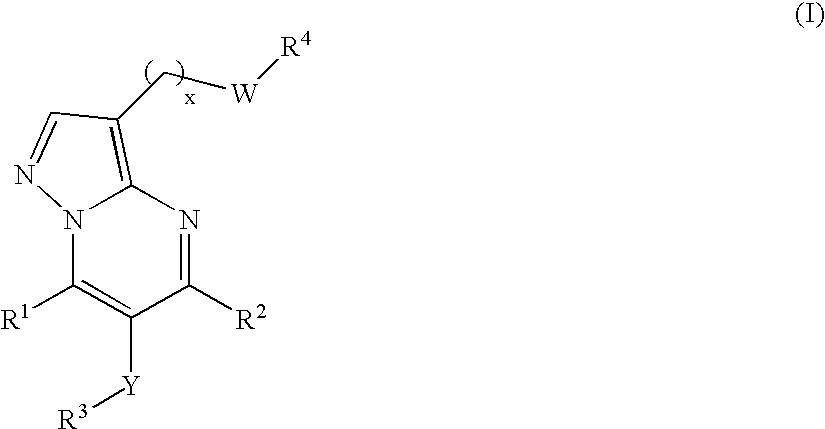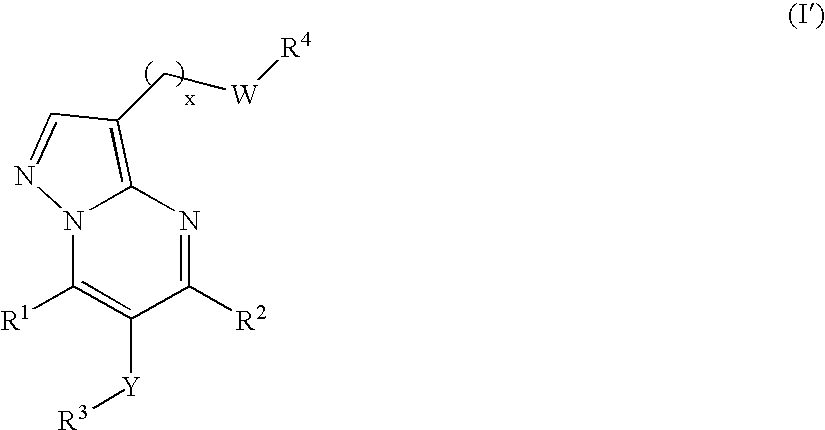New compounds
a new type of compound technology, applied in the field of compounds, can solve the problems of reducing the inhibition level of scd1 expression, and showing that such compounds are capable of modulating scd activity, and achieve the effects of regulating lipid levels and composition, and modulating scd activity
- Summary
- Abstract
- Description
- Claims
- Application Information
AI Technical Summary
Benefits of technology
Problems solved by technology
Method used
Image
Examples
example 1
tert-Butyl[2-({[6-(3,4-dichlorobenzyl)pyrazolo[1,5-α]pyrimidin-3-yl]carbonyl}-amino)ethyl]carbamate
[0370]
[0371]A solution of 6-(3,4-dichlorobenzyl)pyrazolo[1,5-α]pyrimidine-3-carboxylic acid (INTERMEDIATE 8, 45 mg, 0.15 mmol) in DMF (6 mL) was treated with tert-butyl (2-aminoethyl)carbamate (27 mg, 0.17 mmol) followed by TBTU (57 mg, 0.18 mmol) and triethylamine (18 mg, 0.18 mmol). The mixture was stirred at r.t. overnight and purified by preparative HPLC (XTerra C18, 50 mM NH4HCO3 pH 10—CH3CN) to give the title compound as a brown solid (60 mg, 86%). A part of the product (5 mg) was repurified by preparative HPLC (ACE C8, 0.1% TFA—CH3CN) to give the title compound as a white solid (0.2 mg). MS (ESI+) calcd for C21H23Cl2N5O3 463.1178, found 463.1177.
example 2
6-(3,4-dichlorobenzyl)-N-{2-[(pyrazin-2-ylcarbonyl)amino]ethyl}pyrazolo[1,5-α]-pyrimidine-3-carboxamide
[0372]
[0373]tert-Butyl[2-({[6-(3,4-dichlorobenzyl)pyrazolo[1,5-α]pyrimidin-3-yl]carbonyl}amino)-ethyl]carbamate (EXAMPLE 1, 60 mg, 0.13 mmol)) was dissolved in a mixture of DCM / TFA (4 mL, 50:50) and stirred at r.t. for 30 min. The reaction mixture was concentrated to give 2-({[6-(3,4-dichlorobenzyl)pyrazolo[1,5-α]pyrimidin-3-yl]carbonyl}-amino)ethanaminium trifluoroacetate (45 mg, 95%) as a yellow gum.
[0374]The crude trifluoroacetate (15 mg, 0.040 mmol) was dissolved in DMF (2 mL) and treated with 2-pyrazinecarboxylic acid (6.5 mg, 0.050 mmol) followed by TBTU (17 mg, 0.054 mmol) and triethylamine (5.4 mg, 0.054 mmol). The mixture was stirred at r.t. for 3 h and then purified using preparative HPLC (ACE C8, 0.1% TFA—CH3CN) to give the title compound (0.9 mg, 5%) as a white solid. MS (ESI+) calcd for C21H17Cl2N7O2 469.0821, found 469.0821.
Intermediate 15
6-(3,4-dichlorobenzyl)-N-[2-(...
example 3
6-(3,4-Dichlorobenzyl)-N-[2-(methylsulfinyl)ethyl]pyrazolo[1,5-α]pyrimidine-3-carboxamide
[0377]
[0378]6-(3,4-Dichlorobenzyl)-N-[2-(methylthio)ethyl]pyrazolo[1,5-α]pyrimidine-3-carboxamide (INTERMEDIATE 15, 4 mg, 0.01 mmol) was dissolved in phenol (0.5 mL) and treated with 30% (w / w) hydrogen peroxide (0.6 μL, 0.02 mmol) at r.t. for 1 min. The reaction mixture was purified by preparative HPLC (XTerra C18, 50 mM NH4HCO3 pH 10—CH3CN) to give the title compound (1 mg) as a white solid. MS (ESI+) calcd for C17H16Cl2N4O2S 410.0371, found 410.0366.
PUM
| Property | Measurement | Unit |
|---|---|---|
| Therapeutic | aaaaa | aaaaa |
| Level | aaaaa | aaaaa |
Abstract
Description
Claims
Application Information
 Login to View More
Login to View More - R&D Engineer
- R&D Manager
- IP Professional
- Industry Leading Data Capabilities
- Powerful AI technology
- Patent DNA Extraction
Browse by: Latest US Patents, China's latest patents, Technical Efficacy Thesaurus, Application Domain, Technology Topic, Popular Technical Reports.
© 2024 PatSnap. All rights reserved.Legal|Privacy policy|Modern Slavery Act Transparency Statement|Sitemap|About US| Contact US: help@patsnap.com










